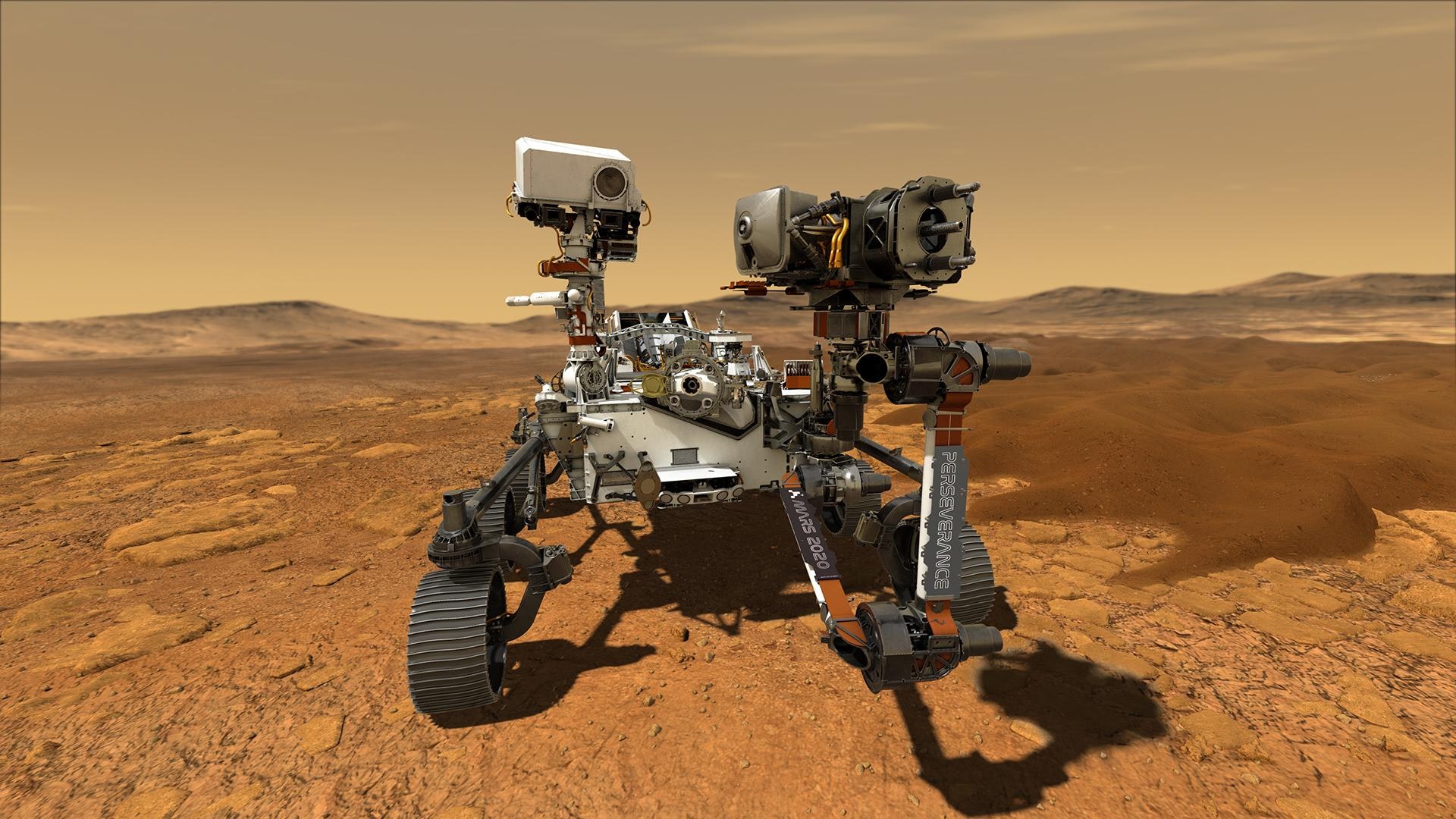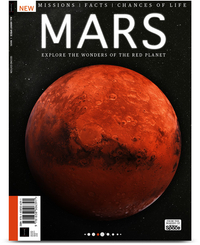
We're about to experience Mars in an entirely new way.
NASA's Perseverance Mars rover will land on Thursday (Feb. 18), kicking off a pioneering surface mission that will hunt for signs of ancient life, collect and cache samples for future return to Earth, and demonstrate a Red Planet helicopter and other advanced exploration tech.
Perseverance is also equipped with two microphones, which will break new ground as well. Past rovers have seen, touched, tasted and smelled Mars in their own robotic fashion, but none has yet captured true audio on the Red Planet.
Related: How to watch NASA's Perseverance rover land on Mars
Perseverance rover's Mars landing: Everything you need to know
"Having a sound of another planet is another way that we can start to realize that it feels familiar," Nina Lanza, team lead for space and planetary exploration at the U.S. Department of Energy's Los Alamos National Laboratory in New Mexico, told Space.com.
"It will add a dimension that will make [Mars] more of a real place to us," said Lanza, who's on the science team for Perseverance's rock-zapping, microphone-equipped SuperCam instrument.
Book of Mars: $22.99 at Magazines Direct
Within 148 pages, explore the mysteries of Mars. With the latest generation of rovers, landers and orbiters heading to the Red Planet, we're discovering even more of this world's secrets than ever before. Find out about its landscape and formation, discover the truth about water on Mars and the search for life, and explore the possibility that the fourth rock from the sun may one day be our next home.
Third time's the charm?
Perseverance, the centerpiece of the $2.7 billion Mars 2020 mission, isn't the first NASA robot to carry audio equipment to the Red Planet.
Breaking space news, the latest updates on rocket launches, skywatching events and more!
The agency's Mars Polar Lander spacecraft sported a microphone, and the Phoenix lander had one built into its descent camera. But neither mic returned any data; Mars Polar Lander crashed during its touchdown attempt in December 1999, and Phoenix's descent camera was never turned on due to concerns that its use could complicate the entry, descent and landing (EDL) process. (Phoenix landed safely in May 2008 and found buried water ice during its successful surface mission.)
Perseverance will try to achieve what Phoenix could not — to record the sounds of its harrowing "seven minutes of terror" touchdown sequence. During Thursday's EDL, the six-wheeled rover will hit the Martian atmosphere at about 12,500 mph (20,000 kph), deploy a supersonic parachute and be lowered to the floor of the 28-mile-wide (45 kilometers) Jezero Crater on cables by a rocket-powered sky crane. So the audio captured by Perseverance's EDL mic and accompanying video taken by seven EDL cameras will be stunning, if everything goes according to plan.
"This is going to be another incredible opportunity to really blow people's minds," musician Jason Achilles Mezilis, a member of the EDL mic team, told Space.com.
"If we get that audio and that video, and we're able to pair that together, that's going to be something nobody's ever seen before," said Mezilis, who was hired as a consultant on the project via his company, Zandef Deksit Inc. "Video from another planet, with sound — that's going to be awesome."
(Perseverance's predecessor, the Mars rover Curiosity, captured amazing imagery during its sky-crane EDL in August 2012, but that footage is silent.)
NASA's Mars rover Perseverance landing: Everything you need to know
The Mars 2020 EDL mic is an off-the-shelf instrument built by the Danish company DPA Microphones. It has a "digitizer puck" that allows it to be hooked up to a cell phone via a USB interface — a feature that also enables connection with a rover's computer, the Perseverance team realized.
The digitizer puck "was the 'eureka!' that we were looking for," Dave Gruel, the lead engineer for the EDL camera and microphone subsystem, told Space.com.
"From that, we were able to baseline a very capable and robust microphone as part of our EDL cam system," added Gruel, who's based at NASA's Jet Propulsion Laboratory (JPL) in Southern California, which manages the Mars 2020 mission.
Gruel and his team didn't need to do much to get the EDL mic ready to fly. They just built a mount for it on Perseverance's body and installed a screen to keep Martian dust out of the microphone's diaphragm, the membrane that vibrates in response to sound waves. They also removed the digitizer puck's electronics board and repackaged it in a way that allowed it to be bolted firmly to the rover.
"And that's it," Gruel said.
The EDL mic has passed three health checks during flight, Gruel said, and the instrument successfully picked up mechanical vibrations generated by one of Perseverance's pumps in October. (The rover launched on July 30, 2020.) So he's "cautiously optimistic" that the mic will work on Thursday — and it might even keep ticking beyond that.
"If it's working throughout the entry, descent and landing phase and it makes it to the surface successfully, I think it's going to keep working for a period of time," Gruel said.
The EDL mic isn't optimized for the harsh conditions of Mars, so the planet's cycling but ever-frigid temperatures will likely break one of its components sooner or later, Gruel said.
SuperCam, too
Even if the EDL mic conks out shortly after Perseverance lands, the rover will still have a microphone with which to record the sounds of the Martian surface — the one built into its SuperCam instrument suite, which sits on the robot's head-like mast.
SuperCam is similar to Curiosity's ChemCam, but the older rover's instrument doesn't have a mic. Perseverance will use SuperCam to study rock and soil from a distance. Part of this work will involve firing a laser at targets up to 20 feet (6.5 meters) away, generating a tiny cloud of vaporized rock the chemistry of which can be interrogated by SuperCam's cameras and spectrometers.
The SuperCam mic will record the sound of this rock zapping, which will be a "snap" rather than a "pew," Lanza said. (The sound comes from a shockwave generated by the heat and vibration of the rock vaporization.) Each snap will harbor a lot of useful information, revealing key details about the zapped rocks, such as their hardness.
For example, subtle changes in the sound will likely allow the SuperCam team to determine if a rock target has a coating, Lanza said. Coatings are of great interest to the Mars 2020 team. These thin features record the history of a rock's interaction with its environment, and they're often associated with past exposure to liquid water. In addition, here on Earth, rock coatings provide great habitats for microbes, affording them some protection from the exterior environment while also allowing them to access its resources.
"So, trying to find a rock coating is really important on Mars, because it tells you, first of all, there's probably a history of water interacting with that surface," Lanza said. "And then, that's another place to start looking for the chemical signatures of life."
Sound recorded by the SuperCam microphone will also help scientists learn more about the thin, carbon dioxide-dominated Martian atmosphere, providing data that informs and improves modeling efforts, she added.
And the SuperCam mic will likely record more than just rock zappings. It can operate for about 3.5 minutes at a time, giving the Perseverance team plenty of opportunities to capture the whoosh of the Martian wind, the crunch of the rover's wheels against the red dirt and other sounds.
Both the SuperCam mic and the EDL mic might also record audio of Perseverance's internal whirrings and workings, which could help the mission team assess the health of various instruments and components, NASA officials have said.
It's even possible that the two mics could capture sounds generated by the Mars helicopter. Early in the mission, the little 4-lb. (1.8 kilograms) craft, known as Ingenuity, will attempt to become the first rotorcraft ever to fly on a world beyond Earth. High-pitched sounds attenuate dramatically in the thin Martian air, but it's possible that the microphones will pick up some of the lower-frequency audio generated by Ingenuity's churning blades, Lanza, Gruel and Mezilis said.
And the two microphone teams may end up working together a bit, synchronizing their operations at times to gather stereo sound on the Martian surface, the researchers said. Such efforts have not yet been planned, however; collaborative conversations will begin in earnest after Perseverance touches down safely (knock on wood) and the teams have had time to assess the condition of their instruments and their goals going forward.
Indeed, it's far too early to predict exactly what the Mars microphones will end up teaching us.
"Who knows what a dust devil might sound like as it goes by the rover? Who knows what interesting things you might detect as the parachute inflates in the Martian atmosphere, and what that sound might be like?" Gruel said.
"Who knows what we're going to learn?" he added. "It's that unknown that adds even more excitement to the whole thing."
Mike Wall is the author of "Out There" (Grand Central Publishing, 2018; illustrated by Karl Tate), a book about the search for alien life. Follow him on Twitter @michaeldwall. Follow us on Twitter @Spacedotcom or Facebook.
Join our Space Forums to keep talking space on the latest missions, night sky and more! And if you have a news tip, correction or comment, let us know at: community@space.com.

Michael Wall is a Senior Space Writer with Space.com and joined the team in 2010. He primarily covers exoplanets, spaceflight and military space, but has been known to dabble in the space art beat. His book about the search for alien life, "Out There," was published on Nov. 13, 2018. Before becoming a science writer, Michael worked as a herpetologist and wildlife biologist. He has a Ph.D. in evolutionary biology from the University of Sydney, Australia, a bachelor's degree from the University of Arizona, and a graduate certificate in science writing from the University of California, Santa Cruz. To find out what his latest project is, you can follow Michael on Twitter.

